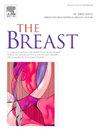Prognostic value of tumor-infiltrating lymphocytes in irradiated node-positive breast cancer patients
IF 7.9
2区 医学
Q1 OBSTETRICS & GYNECOLOGY
引用次数: 0
Abstract
Introduction
Radiotherapy significantly reduces locoregional recurrence (LRR) and improves survival. Yet, reliable biomarkers predicting radiotherapy response are not well-defined. Tumor-infiltrating lymphocytes (TILs) have emerged as a promising prognostic and predictive marker, but their role in irradiated patients remains underexplored.
Methods
This case-cohort study included 1461 node-positive, irradiated breast cancer patients from the Danish Breast Cancer Group (DBCG) internal mammary node (IMN)2 study. IMN irradiation (IMNI) was allocated by tumor laterality. TILs were assessed in treatment-naïve primary tumors and dichotomized using a 30 % cut-off. Endpoints included overall mortality (OM), breast cancer-specific mortality (BCM), distant recurrence (DR), and LRR. Flexible parametric survival models estimated adjusted hazard ratios (HRs).
Results
TILs were evaluated in 1353 patients; 20 % had high TILs. Low TILs were associated with higher OM (HR 0.53, 95 % CI: 0.36–0.77), BCM (HR 0.45, CI: 0.29–0.71) and DR (HR 0.40, CI: 0.26–0.62), but not LRR (HR 0.82, CI: 0.31–2.17). These associations were strongest in estrogen receptor-negative (ER-) tumors. ER-/low TILs were associated with increased OM (HR 0.31, CI: 0.18–0.56) compared to ER-/high TILs, whereas TILs were not prognostic in ER+ tumors (HR 0.86, CI: 0.56–1.32). A significant survival benefit after IMNI was observed in patients with low TILs tumors (HR 0.64, CI: 0.48–0.85), but TILs did not predict IMNI-benefit.
Conclusion
TILs in the pre-immunotherapy setting were not predictive of IMNI-benefit but prognostic for post-radiotherapy outcomes in node-positive patients. The effect was dependent on ER status, as patients with ER-/low TILs tumors had poorer survival with a trend toward increased DR-risk.
肿瘤浸润淋巴细胞在放疗后淋巴结阳性乳腺癌患者中的预后价值
放疗可显著降低局部复发(LRR),提高生存率。然而,预测放射治疗反应的可靠生物标志物尚未明确定义。肿瘤浸润淋巴细胞(til)已成为一种有希望的预后和预测指标,但它们在放疗患者中的作用仍未得到充分探讨。方法本病例队列研究纳入1461例丹麦乳腺癌组(DBCG)内乳腺淋巴结(IMN)2研究中淋巴结阳性、放疗的乳腺癌患者。IMN照射(IMNI)根据肿瘤的侧边度进行分配。在treatment-naïve原发肿瘤中评估til,并使用30%的截断率进行二分类。终点包括总死亡率(OM)、乳腺癌特异性死亡率(BCM)、远处复发率(DR)和LRR。灵活参数生存模型估计调整风险比(hr)。结果1353例患者进行了stil评价;20%的患者TILs较高。低TILs与较高的OM (HR 0.53, 95% CI: 0.36-0.77)、BCM (HR 0.45, CI: 0.29-0.71)和DR (HR 0.40, CI: 0.26-0.62)相关,但与LRR (HR 0.82, CI: 0.31-2.17)无关。这些关联在雌激素受体阴性(ER-)肿瘤中最强。与ER-/高TILs相比,ER-/低TILs与OM增加相关(HR 0.31, CI: 0.18-0.56),而TILs与ER+肿瘤的预后无关(HR 0.86, CI: 0.56-1.32)。在低TILs肿瘤患者中观察到IMNI后显著的生存获益(HR 0.64, CI: 0.48-0.85),但TILs不能预测IMNI获益。结论免疫治疗前的tils不能预测淋巴结阳性患者的imni获益,但可以预测放疗后的预后。这种效果依赖于ER状态,因为ER-/低TILs肿瘤患者的生存期较差,并且有增加dr风险的趋势。
本文章由计算机程序翻译,如有差异,请以英文原文为准。
求助全文
约1分钟内获得全文
求助全文
来源期刊

Breast
医学-妇产科学
CiteScore
8.70
自引率
2.60%
发文量
165
审稿时长
59 days
期刊介绍:
The Breast is an international, multidisciplinary journal for researchers and clinicians, which focuses on translational and clinical research for the advancement of breast cancer prevention, diagnosis and treatment of all stages.
 求助内容:
求助内容: 应助结果提醒方式:
应助结果提醒方式:


